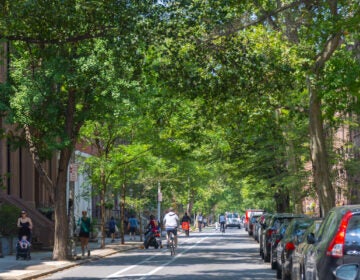‘Open-door’ policy fuels togetherness for one Mount Airy block
Nestled between Emlen and Cherokee Sts., the 400 block of Wellesley Road is home to 50, tightly-packed houses. For residents of the Mount Airy street, the physical makeup has led to a tightly-knit community.
Many neighbors say a recent increase in the number of children has played a big part in maintaining the block’s small-town feel. With no yards or driveways, the asphalt serves as their playground.
“You have to know your neighbors. It forces you to kind of be outside more,” said Aura Gersenson, who moved to the west end of Wellesley three years ago.
Gerenson, a single mother, said that situation has led to an unexpected one where she receives help raising her three-year-old daughter.
” Every parents has those moments, and a little bit of the difference is that I don’t have a partner to say, ‘ You deal with this,'” she said. ” But I can go out on my porch and say ‘Ah’ and someone will come [and] take over for a few minutes.”
Jacqui Anderson, who has lived on the block for about 10 years, said that the street is “really like an open-door community. The kids are always running in and out of each other’s houses and waiting for each other at the bus stop.”
“If someone has to go the market for five minutes or something, you can drop your kid off at somebody’s house,” said Teddy Heck.
In the same vein, many residents said that doors are seemingly open in the figurative sense as well.
Kathy Sutton moved to the street 33 years ago in hopes of finding a neighborhood that would welcome her children.
“We knew our kids would be perceived as racially mixed, even though we’re both African-American, and this area was the most friendliest toward everybody,” Sutton said. “They don’t even look like they’re siblings, but we figured, a neighborhood like this, nobody really cared.
“It seems we have a capacity to attract all nice people,” she said.
Despite the current diversity described by neighbors, veteran resident Alice Williams Gaines said it wasn’t always that way. She purchased her home in 1963, as the Civil Rights struggle waged on.
“There were a lot of older white people,” said Gaines, a 94-year-old African-American woman. “When you stop and think of the age of the people who were here that moved, they were older people – they were well indoctrinated with prejudices and all those things that existed.”
Gaines said that many of her original neighbors moved away in subsequent years, making room for new neighbors and new mentalities.
“The thing I like most about the neighborhood today is the attitude and the intelligence of the young people who moved here today,” Gaines said. “We have more interaction.”
“People are people, regardless of your nationality or what your skin color is,” she added.
Gaines doesn’t mind the children either.
“They come, they go, they sit on my porch, they chit chat,” she said.
The neighborly bonds have also allowed the block to host annual events – including cleanups and “progressive” holiday dinner parties, in which neighbors move from house to house for different courses.
But Gersenson said most community interactions are unplanned.
“It’s sort of impromptu like ‘Oh I’m home on a Friday night, you’re home on a Friday night,'” she said. “Usually the first cold snow, we’ll get a pit and have a fire.”
Block Captain Holly Hill moved to the street in 1999. Her responsibilities largely entail checking on and communicating with residents, usually if there are crimes or events that need to be known, she said. Mostly, though, she does it for the neighborly company.
“I consider myself lucky because my neighbors are my friends, too,” Hill said.
And while some neighbors have moved away and other families have moved in, many contend that the block still has a lingering impact on people after they’re gone.
“People, when they move away, they still keep in contact. They move, but they don’t move,” Sutton said.
WHYY is your source for fact-based, in-depth journalism and information. As a nonprofit organization, we rely on financial support from readers like you. Please give today.




